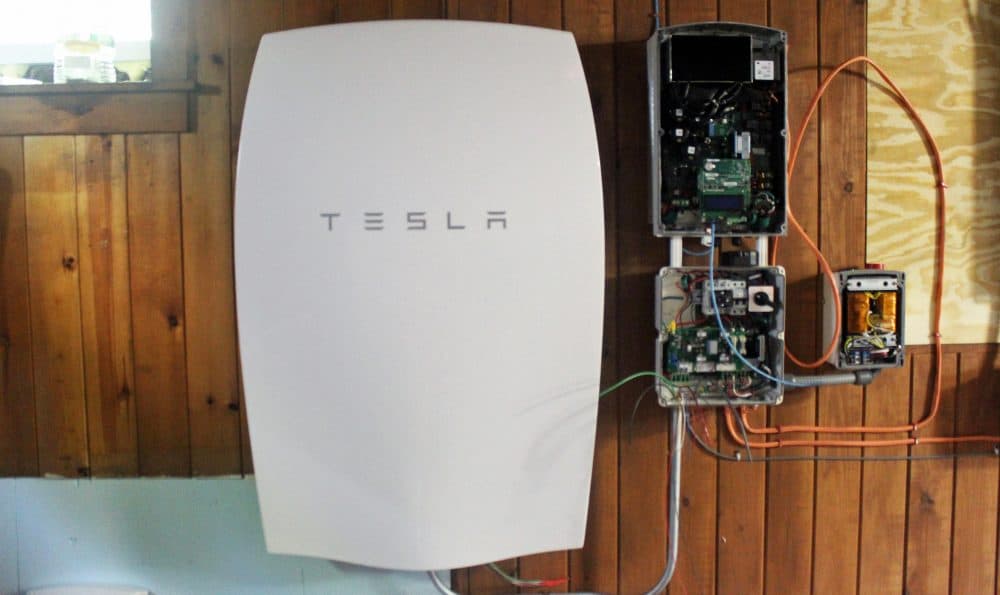Advertisement
Vermont Utility Bets Home Batteries Are The Way Of The Future
Resume
As our reliance on solar and wind energy grows, so does the challenge of reliability. You can’t turn the wind and sun on whenever you need electricity.
One part of the solution is energy storage. That’s why Vermont’s largest utility is selling Tesla home batteries to its customers -- both for the homeowner’s private use and for the utility to draw on as a source of electricity.
Green Mountain Power is the first utility in the country to pilot the Tesla Powerwall battery in this way. The utility is betting that this could be the way of the future.
Not Just A Luxury Item
That future is becoming a reality in the basement of Miguel Orantes' southern Vermont home.
Electrician Scott Millette is installing Tesla's gleaming white Powerwall battery pack on Orantes' wall. The sleek plastic arc looks somewhat out of place hanging on the old, wood-paneled wall in the rustic basement.
"It looks kinda like a spaceship!" Millette said.

Millette is installing the lithium-ion battery and the inverter, and connecting the whole system both to the house and to the grid.
"We’ve got the Powerwall, inverter, DC to AC power and vice versa, to charge the battery," he explained.
The inverter is key. It allows the utility to draw energy out of the battery and pull it into the grid, as well as send it to other people's home.
The battery itself stores about 6.4 kilowatt-hours of energy, which could power the barebones needs of an average home for about six hours. It seamlessly kicks on whenever there’s a power outage.
For homeowner Miguel Orantes, it’s not just a luxury item. His doctors recommended he have some kind of power backup so his medical alert system would still work in the event of an outage. Orantes is disabled and walks with a cane.
"My fear has been, what if I fall and there’s no one around?" Orantes said.
One day last year when he was paying his utility bill, Orantes saw an advertisement on the Green Mountain Power website for the Tesla Powerwall battery.
He had thought about getting a generator before, as backup for possible power outages, but he didn’t want to keep gasoline around and deal with the maintenance.
"And it doesn’t hurt that it’s made by Tesla," he said. "If it wasn’t Tesla, probably would have thought twice about it. Being familiar with their cars, you know, I thought, 'OK, well that’s worthy.' "
The utility, Green Mountain Power, isn’t getting a discount from Tesla. The battery and the inverter combined cost about $6,500. But Orantes has opted to pay in monthly installments of about $37 a month for 10 years, which is a total of $4,500. The price is reduced for homeowners who allow Green Mountain Power to pull power from the battery.
Right now Orantes is charging his battery from the grid, but others who are buying the Powerwall will be charging them from their rooftop solar arrays.
For Green Mountain Power, the batteries represent an important step forward in how small-scale renewable energy can be part of the larger energy mix.
Josh Castonguay, with Green Mountain Power, said when these 500 batteries are installed in basements scattered across Vermont they will act sort of like a virtual power plant made up of lots of tiny energy generators all connected to the grid.
"It is a system," he explained. "You’re essentially taking what used to be [a] couple bulk plants to thousands of points out on [the] grid that all need to be choreographed together."
That choreography needs to take into account whether the sun is shining, the wind is blowing, and how much electricity consumers are using at peak times — like when everyone gets home from work and turns on the AC, TVs and stove. All of this information is needed to determine if the batteries should be charging from the sun or the grid, or sending out energy during times of high consumer demand.
Castonguay said this pilot project with the 500 Tesla Powerwalls will be a way to test and refine that complex algorithm.
"If the customer chooses the option where they’re sharing access," he said, "when a peak time comes, we can have it scheduled to say, OK, start discharging between this hour and this hour and then refill it right back up and have it available for the customer in case of an outage."
Incorporating Batteries Into The Grid
"One of the biggest challenges is intelligently coordinating hundreds, thousands of Powerwalls," said Mads Almassalkhi, an assistant professor of electrical engineering at the University of Vermont.
He said if utilities can figure out how to incorporate these batteries into the grid, they could someday drastically reduce reliance on natural gas fired plants that they keep on standby for when they need to ramp up power quickly.
"If we can regulate this in a smart way, you can also cancel out the variability that’s introduced from renewable energy," he explained.
Despite that variability from weather — and unpredictable consumer use of renewables — on a sunny day, Vermont can get up to 20 percent of its energy from solar power.
Once all 500 Tesla Powerwalls are hooked up to the grid, those basement batteries will be able to store about one megawatt of power, roughly enough to power about 170 homes.
It might not seem like much, but in a state that’s banking on renewable energy, it’s enough to keep the lights on.
This story is a production of the New England News Collaborative and originally aired on Vermont Public Radio.
This segment aired on June 28, 2016.